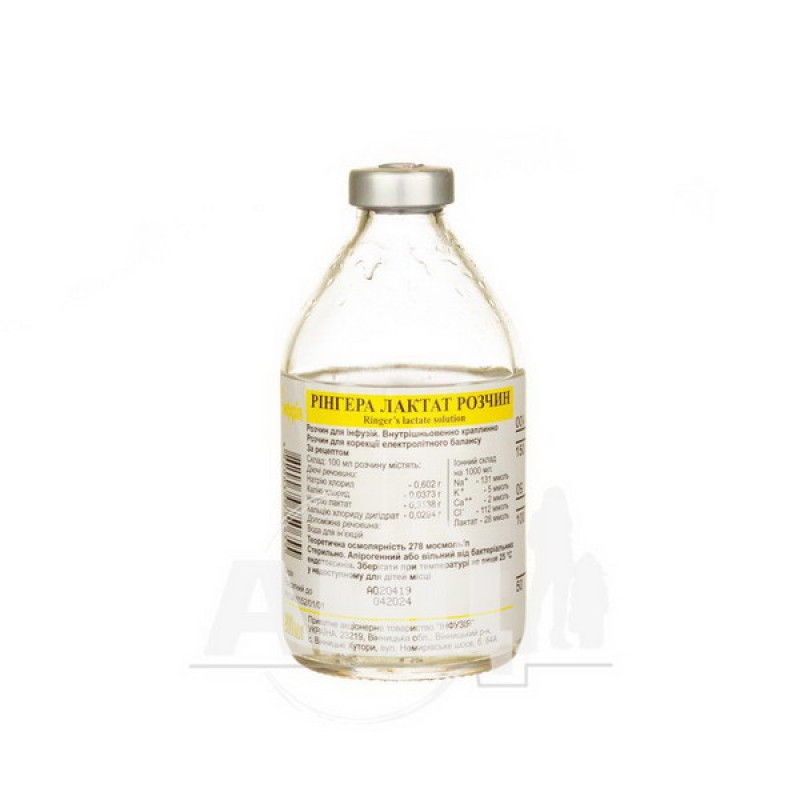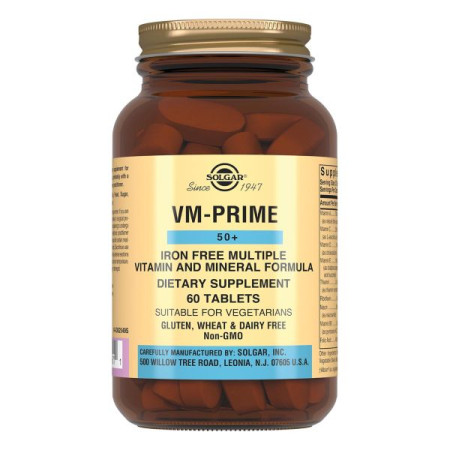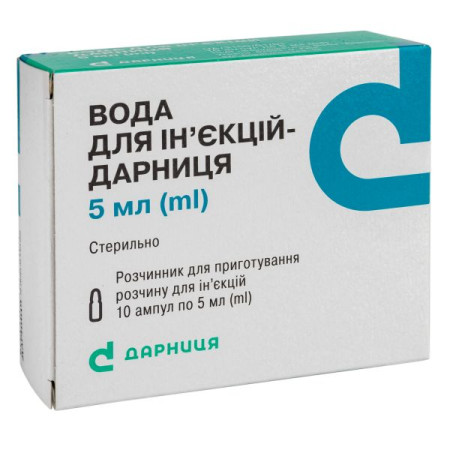Ringer's lactate solution for infusion, 200 ml bottle

Translation of the instructions can be
RINGER'S lactate solution solution for infusionInstruction
For medical use of the medicinal product
Ringer's lactate solution
(Ringer's lactate solution)
Composition:
Active ingredients: sodium chloride, potassium chloride, sodium lactate, calcium chloride dihydrate;
100 ml of solution contains: sodium chloride - 0.602 g; potassium chloride - 0.0373 g; sodium lactate - 0.3138 g; calcium chloride dihydrate - 0.0294 g;
ionic composition per 1000 ml of solution: Na + - 131 mmol, K + - 5 mmol, Ca ++ - 2 mmol,
Cl - - 112 mmol, lactate - 28 mmol;
excipients: water for injections.
Dosage form.
Solution for infusion.
Main physicochemical properties: clear colorless liquid; theoretical osmolarity - 278 mosmol/l; pH 5.5-7.5.
Pharmacotherapeutic group.
Plasma replacement and perfusion solutions. solutions for correction of electrolyte balance disorders. electrolytes.
PBX code B05B B01.
Pharmacological properties.
Pharmacodynamics. "Ringer's lactate solution" - a saline solution with a balanced electrolyte content. fills the deficit of the circulating blood volume. lactate, which is part of the drug, as a result of metabolic processes is converted into bicarbonate anions, which slightly changes the blood reaction to the alkaline side. the solution also has a detoxification effect due to a decrease in the concentration of toxic products in the blood and activation of diuresis. the solution is close to isotonic.
Pharmacokinetics. When administered intravenously, the blood osmolarity increases for a short time. The drug penetrates the tissues after about half an hour. The components of the drug are excreted in the urine.
Clinical characteristics.
Indication.
Correction of water and electrolyte balance disorders in isotonic and hypotonic dehydration due to fluid loss during vomiting, diarrhea, insufficient fluid intake into the body, biliary and intestinal fistulas, as well as for restoring water and electrolyte balance in preparing patients for surgery and in the postoperative period. metabolic acidosis.
Contraindication.
Hypervolemia, hypernatremia (including due to the use of corticosteroids), hyperkalemia, hyperchloremia, hypertensive dehydration, alkalosis, lactic acidosis, severe arterial hypertension, severe cardiac and/or renal dysfunction, hepatic failure (due to reduced formation of bicarbonate from lactate), pulmonary edema, thrombophlebitis, conditions with increased blood clotting, decompensated heart disease.
Oliguria, anuria; acute renal failure; cerebral edema; hypercalcemia; extracellular hyperhydration.
Interaction with other drugs and other types of interactions.
The use of potassium-sparing diuretics, angiotensin-converting enzyme (ACE) inhibitors and potassium preparations increases the risk of developing hyperkalemia. The simultaneous use of the drug "Ringer's lactate solution" and cardiac glycosides increases the toxic effect of the latter due to the presence of Ca ++ ions in the solution.
The drug is incompatible with cefamandole, amphotericin, ethyl alcohol, thiopental, aminocaproic acid, metaraminol, ampicillin, vibramycin and monocycline.
It is not recommended to use "Ringer's lactate solution" as a means for diluting antibiotics administered by infusion, as well as for diluting anti-inflammatory drugs.
Sodium retention in the body may increase with the simultaneous use of the following drugs: nonsteroidal anti-inflammatory drugs (NSAIDs), androgens, anabolic hormones, estrogens, corticotropin, mineralocorticoids, vasodilators or ganglioblockers.
Due to the presence of lactate in the composition of the drug, which alkalizes the pH, caution should be exercised when using "Ringer's lactate solution" simultaneously with drugs whose renal elimination depends on the pH. Renal clearance of salicylates, barbiturates, lithium may decrease, and sympathomimetics and stimulants (such as dexamfetamine sulfate, fenfluramine hydrochloride) may increase.
Application features.
During infusion therapy with the drug "Ringer's lactate solution", it is necessary to assess the patient's clinical condition based on monitoring the concentration of electrolytes, water-electrolyte balance, pH and pCO2, and lactate level (when performing massive infusions).
Due to the content of sodium ions, "Ringer's lactate solution" should be used with caution in patients with arterial hypertension, renal and cardiovascular failure, elderly patients, as well as patients with clinical conditions accompanied by sodium retention and edema, patients with hypoxia and hepatic failure.
The use of intravenous solutions can cause fluid overload, hyperhydration, congestion, and pulmonary edema. The risk of dilution is inversely proportional to the electrolyte concentration. The risk of fluid overload, which causes congestion with peripheral edema and pulmonary edema, is directly proportional to the electrolyte concentration.
Since the drug contains sodium lactate, it should be used with caution in patients prone to hypernatremia (for example, with adrenocortical insufficiency, diabetes insipidus or massive tissue damage) and in patients with heart disease; due to the content of sodium ions, the solution should be used with caution in patients with renal and cardiovascular failure, with congestive heart failure, especially in the postoperative period, as well as in patients with clinical conditions accompanied by sodium retention and edema.
Solutions containing sodium should be administered with caution to patients using corticosteroids or corticotropin.
Due to the potassium content, caution is required when using the solution in patients with heart disease and clinical conditions that are accompanied by potassium retention in the body.
If calcium is prescribed, cardiac function should be monitored by electrocardiography (ECG), especially in patients receiving digitalis. Serum calcium levels do not always reflect tissue calcium levels.
In patients with reduced kidney function, the use of the solution may lead to sodium or potassium retention in the body.
Due to the presence of calcium ions in the solution, caution is required when using blood products simultaneously, as coagulation may develop.
When administering parenteral calcium to patients receiving cardiac glycosides, special attention is required.
Lactate is a substrate for gluconeogenesis, so it is necessary to carefully monitor blood glucose levels in patients with type 2 diabetes.
Use during pregnancy or breastfeeding.
The drug should be used for vital indications when the expected benefit to the mother outweighs the possible risk to the fetus/child.
The ability to influence the reaction speed when driving vehicles or other mechanisms.
Data are missing due to the use of the drug exclusively in a hospital setting.
Method of administration and doses.
Administer intravenously by drip. The dose is prescribed by the doctor depending on the patient's condition. The maximum daily dose for adults is 40 ml/kg/day (on average 2500 ml at a rate of 60 drops/min). The duration of treatment depends on the patient's condition.
Children.
Not used in pediatrics due to lack of clinical trials.
Overdose.
Overdose or too rapid administration of the solution may lead to disruption of water and electrolyte balance, alkalosis, cardiopulmonary decompensation. In this case, the administration of the drug should be stopped immediately. Symptomatic therapy should be carried out.
Excessive administration of lactate can lead to the development of metabolic alkalosis, which, in turn, may be accompanied by hypokalemia. Symptoms: mood swings, fatigue, shortness of breath, muscle weakness, polydipsia, polyuria, impaired thinking, arrhythmia. Muscle hypertonicity, twitching and tetanic convulsions may occur in patients with hypocalcemia.
Adverse reactions.
Electrolyte imbalance: changes in serum electrolyte levels (potassium, calcium, sodium, chlorine); metabolic alkalosis; chloride acidosis.
General reactions of the body: hypervolemia; allergic or anaphylactic reactions (fever, itching, cough, sneezing, difficulty breathing, local or generalized urticaria, angioedema).
Changes at the infusion site: inflammation, swelling, redness, rash, itching, burning, pain, numbness at the infusion site, thrombophlebitis.
Mental disorders: panic attack.
Rapid administration of the drug may cause acute circulatory failure and pulmonary edema.
In case of adverse reactions, the administration of the solution should be stopped, the patient's condition should be assessed and appropriate assistance should be provided.
Expiration date.
5 years.
Storage conditions.
Store at a temperature not exceeding 25 ° C. Keep out of the reach of children.
Incompatibility.
The drug cannot be mixed with phosphate- and carbonate-containing solutions.
Packaging.
200 ml or 250 ml, or 400 ml, or 500 ml in bottles.
Vacation category.
According to the recipe.
Producer.
Private Joint Stock Company "Infusion".
Location of the manufacturer and address of its place of business.
Ukraine, 23219, Vinnytsia region, Vinnytsia district, Vinnytsia khutora village, Nemyrivske highway st., 84a
There are no reviews for this product.
There are no reviews for this product, be the first to leave your review.
No questions about this product, be the first and ask your question.










